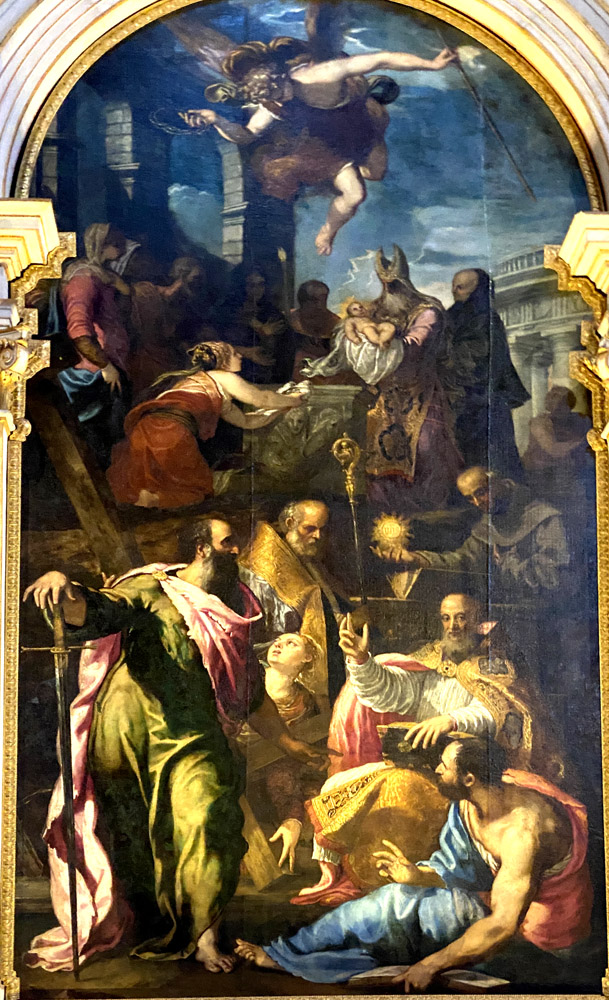
Salviati (Giuseppe Porta, 1520-75)
The Presentation of Jesus in the Temple
Church of Santa Maria Gloriosa dei Frari, Venice, Italy
Most images of the Presentation in the Temple focus on Simeon, the man who took the Christ Child in arms and recognized him as the Savior. But the upper register of this painting instead pictures the "ransoming" of the child required in Exodus 13:12-13:
Thou shalt set apart all that openeth the womb for the Lord, and all that is first brought forth of thy cattle: whatsoever thou shalt have of the male sex, thou shalt consecrate to the Lord. The firstborn of an ass thou shalt change for a sheep: and if thou do not redeem it, thou shalt kill it. And every firstborn of men thou shalt redeem with a price.
In the painting the high priest has received the baby for the Lord, and the young woman kneeling before him offers two doves as the "price" by which the child is "redeemed." The artist reminds the viewer of the typological relation between this ransom and Christ's redemptive sacrifice on the Cross by having the angel hover above with a crown of thorns and what looks to be the sponge-bearer's rod from Crucifixion images. In the York play of the Purification Joseph expresses this typology when he tells Mary not to worry that they cannot afford to get a lamb to offer because the baby "is the lamb of God, I say, that all our sins shall take away" (Davidson, 120).
Mary herself is pictured with her spouse in the shadows on the left, so one might well ask who the young woman with the doves could be. No such woman stands in for the parents in Luke nor in any of the apocrypha, yet one is often pictured in Presentations standing by with the two doves in a basket. In those images she is probably just one of the virgins who had served with Mary in the Temple, but here the artist is most likely upgrading her to a figure of the "holy virgin Church" whose "hidden womb" Christ was to open "for the begetting of nations" (Catena, III, i, 81).
The curve of the young woman's body leads the eye down along the Holy Cross to another way of picturing the Church, the six saints in the lower register. On the left are St. Paul with the sword that is his attribute and St. Peter, with his short, square beard and episcopal crozier. Between them St. Helena holds onto the Cross. On the right, St. Bernardino holds the glowing "IHS" emblem that is his attribute. The other two on the right are hard to identify, although one might guess that the man with the book is Luke, whose gospel narrates the Presentation event.
Intent on the typological reading of the event, the artist has even omitted Simeon, whose witness is strongly emphasized in the liturgy and the plays.1 He does include the widow Anna, the other witness mentioned in Luke who "spoke of him [the child Jesus] to all that looked for the redemption of Israel." In the painting she stands behind the High Priest in her widow's weeds.
View this image in full resolution.
Read more about images of the Presentation in the Temple and the Circumcision.
Read more about images of St. Paul.
Read more about images of St. Helena.
Read more about images of St. Peter.
Read more about images of St. Bernardino.
Read more about images of St. Luke.
Photographed at the church by Richard Stracke, shared under Attribution-NonCommercial-ShareAlike license.